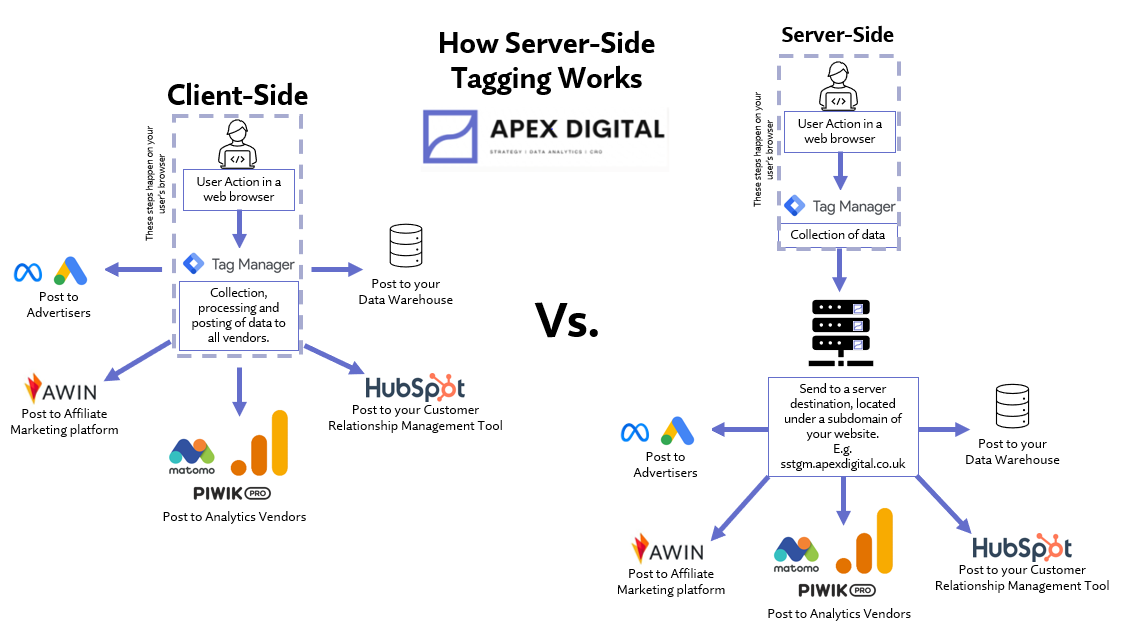Fully Control Your Data flows..
Migrate your data to the cloud with Server Side Tagging and gain benefits you might not have realised were possible.
What is Server Side Tagging?
Instead of sending your data directly to Google Analytics from the user’s web browser, you send the data to your own server for processing and onward destinations.

What’s the purpose?
By sending data once to your server location under your domain name, it is now yours to do what you want with.. It is first party data.
Benefits of Server Side Tagging
- First party data allows you more control. E.g. If you own a car, you can modify it any way you wish and keep it for as long as you like. If you rent a car, you cannot change it. A similar principle applies to your data.
- Server Side Tagging will speed up your website. Instead of processing each request to each vendor separately from within the browser, you burden the browser with a fraction of the workload because all the processing happens on your server.
- Become more trusted with your customers’ data. Privacy is a hot topic in the general public. Become a more responsible partner by keeping data owned and in-house, without risking Personal Identifiable Information leaks to 3rd parties.
- Improve the quality of your digital data. Stop the cookie rot on many browsers that limit cookie lifetimes to 7 days, causing you to lose visibility on marketing campaign effectiveness. Browsers can tell when the data is being sent directly to Google Analytics, but first party data transmission with Server Side Tagging is seen as privacy safe.
- In a similar way, if the end user employs ad blockers or a privacy safe VPN, your own domain is not classed as malicious, so is therefore not blocked.
Would your business benefit?
There are many benefits to Server Side GTM, but beware, it is not a free solution. Expect to pay at least $100 a month in server utilisation and processing costs. You would also need a specialist to set it up and manage the implementation, which are costs to factor in.
There are risks if things do not go right, if suddenly a huge increase in traffic spikes CPU utilisation, or lots of processing begins to occur for complex data flows, this could increase costs. Luckily, there are alerts you can set up in Google Cloud to cap spending.
The decision comes down to the cost vs benefit realisation. If you are a small business, the added complexity and spend may not be required if you deem the data served by 3rd party vendors to be adequate. However, If this investment would be only a small proportion of your marketing budget (which would be most medium to large businesses), the decision to go server-side clearly has benefits outweighing the costs.
Would Server-Side Tagging help your marketing and data governance processes?
Contact me for an introduction call today to discuss if your business is suitable to transition to Server Side Tagging
Read more…
-
Poor Conversion Rate? Conventional ‘CRO’ is not the answer
CRO Best Practices to boost your online platform Answering this question is why we have an industry around Conversion Rate Optimisation (CRO). This article will go over common mistakes and CRO best practices. Fundamentally, understanding data and applying it to the business context is the key to success, however, it’s quite common for CRO to…
-
The Google Analytics 4 Session: How it’s calculated
How are Google Analytics 4 sessions calculated? A common question in marketing is, “How many people visited my website last month?” the answer should be relatively simple. Most marketing analysts would use the go-to metric they have always used, and the stakeholders wouldn’t expect anything else: the Google Analytics 4 session. If we break down…
Connect with me on LinkedIn
